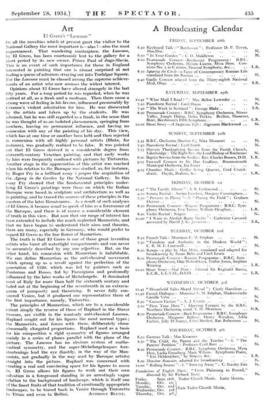Art
El Greco's "Laocoon "
Or all the novelties which at present greet the visitor to the National Gallery the most important is-alas !also the most impermanent. That wandering masterpiece, the Laocoon, by El Greco, has been courteously lent to the gallery for a short period by its new owner, Prince Paul of Jugo-Slavia. This is an event of such importance for those in England interested in painting that one is almost surprised at not finding a queue of admirers straying out into Trafalgar Square. For the Laocoon must be classed among the supreme achieve- ments of an artist who now arouses the widest interest.
Opinions about El Greco have altered strangely in the last fifty years. For a long period he was regarded, when he was noticed at all, as a freak and a madman. Then there came a strong wave of feeling in his favour, influenced presumably by Cezanne's violent admiration for him. He was discovered by the artists and taken up by the students. He was admired, but he was still regarded as a freak, in the sense that he was thought of as an isolated phenomenon, springing from nowhere, leaving no permanent influence, and having no connexion with any of the painting of his day. This view, which has at one time or another been held and then rejected in connexion with all highly personal artists (Blake, for instance), was gradually realized to be false. It was pointed out that El Greco derived in a considerable degree from sixteenth-century Venetian painting, and that early works by him were frequently confused with pictures by Tintoretto. Another stage in the appreciation of this artist was reached when his relation to the Baroque was studied, as, for instance, by Roger Fry in a brilliant essay it propos the acquisition of the Agony in the Garden by the National Gallery. In this essay Fry showed that the fundamental principles under- lying El Greco's paintings were those on which the Italian Baroque were based, in sculpture and architecture as well as in painting, and he traced the sources of these principles in the masters of the later Renaissance. As a result of such analyses of El Greco, it became usual to speak of him as a forerunner of the Baroque, and there is of course a considerable element of truth in this view. But now that our range of interest has been extended to include the much neglected Mannerists, and that we have begun to understand their aims and theories, there are many, especially in Germany, who would prefer to regard El Greco as the fuse flower of Mannerism.
The truth is that El Greco is one of those great inventive artists who burst all watertight compartments and can never be accurately described by any one adjective. But, on the other hand, his connexion with Mannerism is indubitable. We can define Mannerism as the anti-classical movement which sprang up as a revolt against the perfection of the generation of 1520, which was led by painters such as Pontormo and Rosso, fed by Parmigiano and profoundly influenced by the later works of Michelangelo. It dominated most of Italy for more than half the sixteenth century and faded out at the beginning of the seventeenth in an extrava- ganza of pomposity and theorizing. It never fully con- quered Venice, but it produced one representative there of the first importance, namely, Tintoretto.
The principles of Mannerism, which are to a considerable extent simply the reverse of those of Raphael in the Stanze frescoes, are visible in the wantonly anti-classical Laocoon. Raphael sought out for his figures the most normal types ; the Mannerists, and Greco with them, deliberately chose abnormally elongated proportions. Raphael used as a basis for his composition a rigid symmetry of figures arranged mainly in a series of planes parallel with the plane of the picture. The Laocoon has no obvious system of mathe- matical symmetry, and the super-Miehelangelesques fore- shortenings lead the eye (hastily, in the way of the Man- nerists, not gradually in the way used by Baroque artists) straight into the picture. Raphael was concerned with creating a real and convincing space for his figures to move in. El Greco allows his figures to work out their own salvation in a foreground standing in an arrestingly vague relation to the background of landscape, which is itself one of the finest fruits of that tradition of emotionally appropriate landscapes, to be traced back in Venice through Tintoretto to Titian and even to Bellini. A-NTHONY Bians-r.


















































 Previous page
Previous page